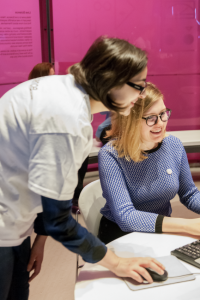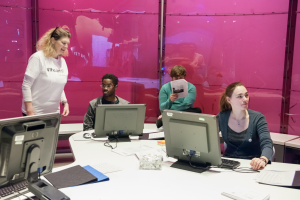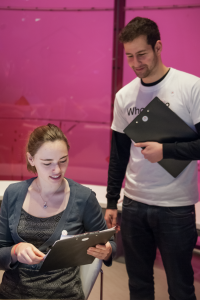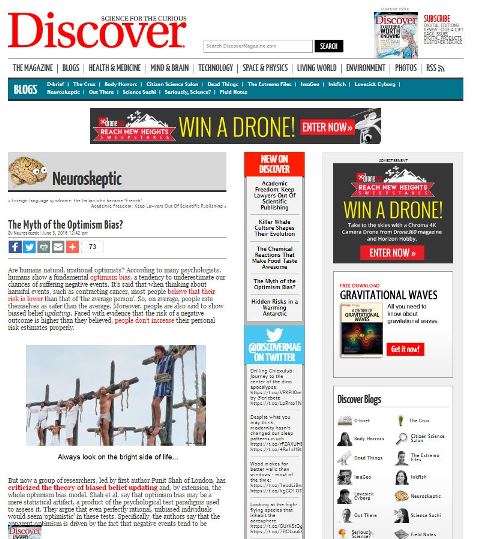In this blog, Dr Lucy Troman, Postdoctoral Research Associate (Biological Sciences) reflects on the adventurous approach taken to help the public understand cell functioning and regulation within the human body and the relevance to cancers, malaria and other disorders.

Dr Lucy Troman: conductor for the Intracellular Express
Earlier this year, in the Summer, myself and a team of Birkbeck’s Biological Sciences researchers attended the GreenMan festival in Wales to communicate our research to the public. Our interactive engagement stall, funded by the Birkbeck Wellcome Trust Institutional Strategic Support Fund (ISSF), used the relatable analogy of catching a train to enable visitor engagement with the transport networks within the cell: the cytoskeleton. This enabled us to communicate some of the cytoskeleton research done here at Birkbeck.
GreenMan is the largest festival in Wales attracting 25,000 people from across the UK with a schedule of world-class live music and comedy. In addition to arts, the award-winning festival houses a dedicated science engagement area, Einstein’s Garden, offering the unique opportunity to reach a diverse audience with a wide range of science capital and literacy, many of whom might not usually engage with science.
Our team played out the role of train conductors and distributed tickets for the Intracellular Express; an interactive scavenger hunt around Einstein’s garden. To participate, members of the public acted as transporters along the cytoskeleton where they had to follow the clues to successfully transport cargo to different organelles within the cell. Over the four-day period we had over 240 people successfully complete the activity and received extremely positive feedback.
The cytoskeleton is primarily made up of three filaments used for cellular structure and organisation: actin, microtubules and intermediate filaments. The dynamic regulation of these filaments allow different specialised cell types to achieve a diverse range of different roles within your body.The key cellular role means the cytoskeleton has an expansive disease relevance. For example, the role of microtubules within cell division makes them an important target for anti-cancer therapeutics. Dysfunctional regulation of microtubules is often associated with neuronal disorder. Additionally, microtubules are critical for viral replication and they play key roles within the life cycle of the parasites responsible for malaria making them important potential targets for both anti-viral and anti-malarial therapeutics.
Both myself and other members of Professor Carolyn Moores research group use a technique called cryo-electron microscopy to determine what these filamentous structures look like and through this we hope to gain insight into their dynamics and regulation both within mammals like humans, but also within parasites. My research looks at comparing the microtubules between different species of frogs. Frogs or Xenopus are good model organisms as they have large eggs containing lots of microtubules, and they have far less complexity than human systems. We are hoping that what we learn about the filaments in frogs will translate back to the same systems within humans.






